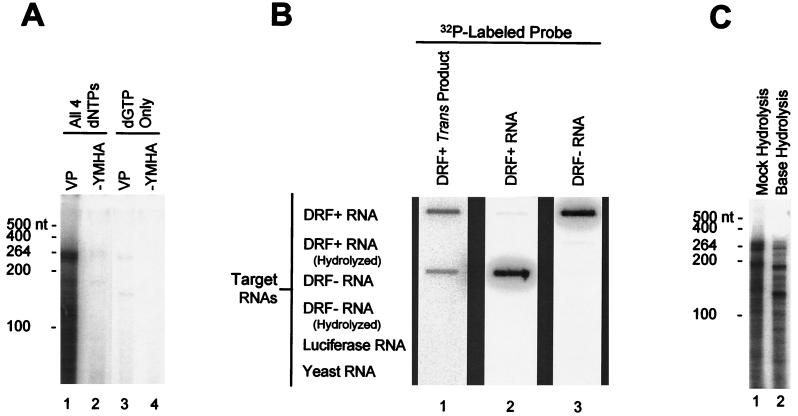FIG. 2.
trans products contain RNA-DNA chimeras produced by reverse transcription of the input RNA. (A) trans reaction requires all four dNTPs. Permeabilized DHBV cytoplasmic cores and DRF+ RNA were employed in the trans reaction in the presence of dATP, dCTP, dTTP, and [α-32P]dGTP (lanes 1 and 2) or with [α-32P]dGTP alone (lanes 3 and 4). VP, wild-type DHBV polymerase; −YMHA, polymerase active-site missense mutant. The mobilities of the single-stranded RNA markers are indicated to the left. (B) trans reaction products hybridize specifically to DRF+ and DRF− RNAs. A trans reaction was performed with permeabilized DHBV viral cores and DRF+ RNA, and the products were purified with phenol and chloroform extraction and were subjected to alkaline hydrolysis to remove any RNA. The RNAs indicated to the left were bound to filters with a slot blot apparatus. The purified trans product was used to probe to filter 1, and internally labeled DRF+ and DRF− RNAs were used to probe filters 2 and 3, respectively. The filters were washed at high stringency. (C) The products of the trans reaction include RNA-DNA chimeras. A trans reaction was performed with permeabilized DHBV viral cores and DRF+ RNA, and the products were purified with phenol and chloroform extraction. Half of the sample was subjected to alkaline hydrolysis, and half was mock hydrolyzed. The samples were then resolved by electrophoresis on a 6% denaturing polyacrylamide gel. The mobilities of the single-stranded RNA size markers are indicated to the left.

